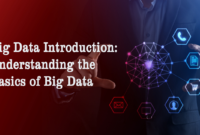In recent years, big data has become a buzzword across industries, from finance to healthcare and beyond. But what exactly is big data? And why is it so important? In this article, we will provide an introduction to big data, including its definition, characteristics, and applications.
Definition of Big Data
Big data refers to large and complex data sets that cannot be easily processed or managed using traditional data processing techniques. These data sets are characterized by the 3Vs: volume, velocity, and variety.
– Volume: Big data refers to data sets that are too large to be managed using traditional data processing techniques. These data sets can range from terabytes to petabytes and beyond.
– Velocity: Big data is generated at a high velocity. This means that data is generated and processed in real-time or near-real-time, making it challenging to process and analyze.
– Variety: Big data comes in a variety of forms, including structured, semi-structured, and unstructured data. This makes it difficult to process and analyze using traditional data processing techniques.
Characteristics of Big Data
In addition to the 3Vs, big data is characterized by several other characteristics, including:
1. Complexity
Big data is complex and can include data from multiple sources, in different formats, and with varying levels of quality. This complexity makes it challenging to process and analyze.
2. Variety
As mentioned earlier, big data comes in a variety of forms, including structured, semi-structured, and unstructured data. This variety makes it challenging to process and analyze using traditional data processing techniques.
3. Real-Time Processing
Big data is generated at a high velocity, which means that it must be processed in real-time or near-real-time to be useful.
4. Privacy and Security Concerns
Big data often includes sensitive information, such as personal information, financial data, and healthcare records. As a result, privacy and security concerns are a major consideration when working with big data.
Applications of Big Data
Big data has numerous applications across industries, including:
1. Healthcare
Big data is being used in healthcare to improve patient outcomes, reduce costs, and improve the overall quality of care. For example, big data can be used to identify high-risk patients and provide targeted interventions to prevent hospital readmissions.
2. Finance
Big data is being used in finance to improve risk management, fraud detection, and customer engagement. For example, big data can be used to detect fraudulent transactions in real-time, helping to prevent financial losses.
3. Marketing
Big data is being used in marketing to improve customer engagement, personalize marketing messages, and increase sales. For example, big data can be used to analyze customer behavior and preferences, enabling marketers to create targeted campaigns.
4. Manufacturing
Big data is being used in manufacturing to improve efficiency, reduce downtime, and improve product quality. For example, big data can be used to monitor equipment performance in real-time, enabling manufacturers to identify and address issues before they cause downtime.
Tools and Technologies for Big Data
To process and analyze big data, organizations use a variety of tools and technologies, including:
1. Hadoop
Hadoop is an open-source framework for storing and processing large data sets. It allows organizations to store and process data across multiple servers, enabling them to handle large data sets more efficiently.
2. Spark
Spark is a data processing engine that allows organizations to process large data sets in real-time or near-real-time. It is designed to be faster and more efficient than traditional data processing techniques.
3. NoSQL Databases
NoSQL databases are designed to handle large and complex data sets. They are flexible and can handle unstructured and semi-
more :

